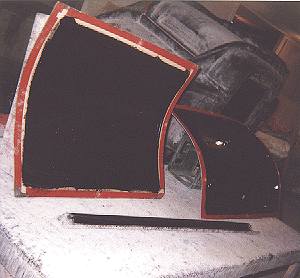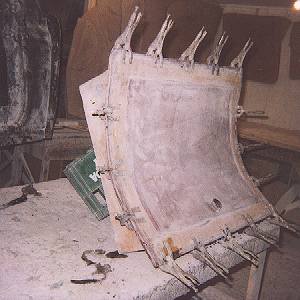|
A Body For Our Project Car - Part 2
by
Frank Colgoni
A Mystery?
Have you've ever considered how a fiberglass body is made? Like a lot
of things, we tend to simply accept that it is made (somehow). Similarly,
we accept that fiberglass is, well, fiberglass. However, while we are
not going to go into the mystery of how glass fibres (yes, real glass)
are created and then woven into fiberglass products, we are going to
share some of the details of how a body is created. In this case, our
body.
It's All in the Lamination
The production method used by Ramrod is one of "open mold laminating"
using hand lay-up and rolling techniques where the fiberglass is reinforced
with resin that has been activated for hardening by a catalyst. When
making a door or trunk lid, which results in a closed (hollow) piece,
two open molds are put together to join the two skins.
The actual body
material is a series of layers starting with a gel coat, which is the
smooth, colour coat, followed by layers of fiberglass cloth, core material
and cloth. The combination of these depends upon the body part being
constructed.
Getting a Smooth
Exterior
The gel coat, which is essentially a layer of pigmented resin, always
goes down first to produce a smooth, sandable outer layer. It has the
ability to reproduce the mold surface exactly. Needless to say, you
need a good mold.
Positive and
Negative (not the electrical variety)
As you would imagine, a finished body is a positive and it's constructed
by combining a series of positive parts made from negative molds (a
3-window coupe body requires 12). The molds were made from positive
parts normally referred to as "plugs". As mentioned above,
a mold needs to be excellent to deliver an excellent fiberglass reproduction.
It might be redundant to say that the plug that generated the mold would
also have to be excellent.
Lets have a look
at a mold:
|





